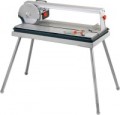Rotation speed
The maximum disc rotation speed provided by the motor of the electric tile cutter. Higher speeds are good for productivity, clean cuts and the ability to handle difficult materials, but they also require the right amount of power.
In general, if a tile cutter is bought for simple work with ordinary facing tiles (for example, repairs in an apartment), you can not pay much attention to this indicator: even the “slowest” models provide enough speed to cope with such tasks. But for cutting specific materials (for example, some types of stone), higher speeds may be required; detailed recommendations on this issue can be found in special sources.
Cutting length
The longest cut that can be made with a tile cutter.
This parameter is relevant primarily for manual tile cutters, as well as for electric stationary units with a top disc feed. In such tools, the cutting element moves along the guide rail and has limited space for movement, and the length of the cut is, in fact, the length of the stroke of the cutting tool from one extreme point to the other. In fact, this is the maximum width of the material that can be cut with a tile cutter.
Cutting depth
The greatest depth to which the tool can cut through the material being processed, in other words, the maximum thickness of the tile that the tile cutter is guaranteed to be able to cut.
It is worth choosing a tool for this parameter taking into account the thickness of the material with which to work, plus some margin “just in case”. But this margin should not be too large: for a
deep cut, large discs and high power are required, which accordingly affects the price, weight and dimensions of the tool.
Folding table legs
The presence of
folding legs at the table on which the electric stationary tile cutter is installed (see "Type"). This feature allows you to significantly reduce the dimensions of the structure for ease of storage or transportation.
Angle stop
The presence of an angular stop in the design of the tile cutter.
The miter fence is designed to make it easier to cut diagonals and other oblique lines. Do not confuse this function with angular cutting: in this case, we are talking about turning the material horizontally, and the cut itself can be normal, vertical. The corner stop is convenient because you can set it to the desired angle in advance, and then fix the tile in it and not worry about it moving during cutting. This is easier than holding the material by hand and controlling the angle in other ways.
Laser marker
The presence in the design of the device of a
laser pointer in the form of a straight line in the direction of movement of the saw blade.
Table dimensions
The size of the working surface of the stationary tile cutter (see "Type"). The larger the table, the lower the likelihood that the tiles will hang from it during operation.

